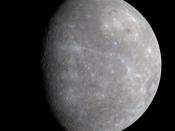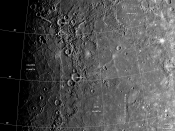Mercury is the closest planet to sun and second smallest in solar system (1st is Pluto). The orbit of Mercury is elliptical than those of other planets of solar system. Its mean distance from Solar System is about 57.93 million kilometers. Its closest approach to the sun Perihelion is 46 million kilometers and farthest approach Aphelion is 70 million kilometers. Mercury's diameter is 4875 kilometers. Its mass is about 3.30 x 1026 grams or 1/18th or 0.06% of Earth's. Its mean density is 5.44 grams per cm3 which is about equal to that of Earth's 5.5 grams per cm3. Mercury's closest approach to the earth is 91700000 kilometers and farthest approach is 218900000 kilometers. Mercury has a longest solar day which lasts for 176 earth days. Because Mercury is closest to sun so its orbital circumference is shortest. So it must race around the sun faster than any other planet in the solar system in order to maintain a stable orbit and position.
That is why it has the shortest solar year which lasts for only 87.96 earth days. Mercury revolves on its orbit at a speed of 47.89 kilometers per second. Its sidereal day (one complete rotation on its axis) is of 58.65 earth days. Mercury's magnetic field is very weak about 1% that of earth's or 6 x 10-4 that of earth's. Because it has a magnetic field (why not very weak), its outer core must be in liquid iron compound which produces a weak magnetic field as it moves. Scientists believe that mercury's crust acts as an effective insulator to keep the planet's outer core liquid despite of very cold temperatures on the dark side of the planet. The core of Mercury probably is relatively larger than that of Earth's core because relatively mercury is smaller in...



Sounds like a lift out of a textbook
If u wrote it, u could rite a txtbook
0 out of 0 people found this comment useful.